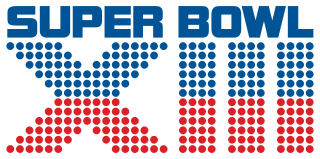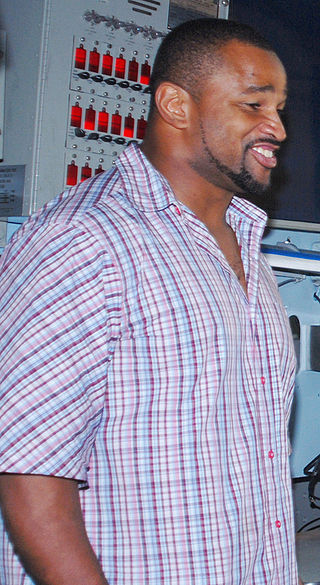Related Research Articles

Super Bowl X was an American football game between the National Football Conference (NFC) champion Dallas Cowboys and the American Football Conference (AFC) champion Pittsburgh Steelers to decide the National Football League (NFL) champion for the 1975 season. The Steelers defeated the Cowboys by the score of 21–17 to win their second consecutive Super Bowl. They were the third team to win back-to-back Super Bowls. It was also the first Super Bowl in which both participating teams had previously won a Super Bowl, as the Steelers were the defending champions and the Cowboys had won Super Bowl VI.

Super Bowl XIII was an American football game between the American Football Conference (AFC) champion Pittsburgh Steelers and the National Football Conference (NFC) champion Dallas Cowboys to decide the National Football League (NFL) champion for the 1978 season. The Steelers defeated the Cowboys by the score of 35–31. The game was played on January 21, 1979, at the Miami Orange Bowl in Miami, Florida, the fifth and last time that the Super Bowl was played in that stadium.
The National Football League playoffs for the 1978 season began on December 24, 1978. The postseason tournament concluded with the Pittsburgh Steelers defeating the Dallas Cowboys in Super Bowl XIII, 35–31, on January 21, 1979, at the Orange Bowl in Miami.
David Lang was an American football running back in the National Football League (NFL) for the Los Angeles Rams and Dallas Cowboys. He played college football at Northern Arizona University.

Lorenzo LaVonne Neal is an American former football fullback who played in the National Football League (NFL) for sixteen seasons. Neal played college football for the Fresno State Bulldogs and was selected by the New Orleans Saints in the fourth round of the 1993 NFL draft. A four-time Pro Bowl selection and three-time All-Pro, he was also a member of the New York Jets, the Tampa Bay Buccaneers, the Tennessee Titans, the Cincinnati Bengals, the San Diego Chargers, the Baltimore Ravens and the Oakland Raiders. Considered one of the best blocking fullbacks in NFL history, Neal blocked for a 1,000-plus-yard running back in eleven straight seasons from 1997 to 2007.

Lousaka Romon Polite is an American former professional football fullback in the National Football League (NFL) for the Dallas Cowboys, Chicago Bears, Miami Dolphins, New England Patriots, and Atlanta Falcons. He played college football at the University of Pittsburgh.
Walter Benton Garrison was an American professional football player who was a fullback in the National Football League (NFL) for the Dallas Cowboys. He played college football for the Oklahoma State Cowboys.
Robert Fulton Newhouse was an American professional football player who was a fullback in the National Football League (NFL) for the Dallas Cowboys for twelve seasons. He played college football for the Houston Cougars.
Thomas Lee Agee is a former American football running back in the National Football League (NFL) for the Seattle Seahawks, Kansas City Chiefs, and Dallas Cowboys. He played college football at Auburn University. He won Super Bowl XXVII and Super Bowl XXVIII with the Cowboys back-to-back, beating the Buffalo Bills in both games.

Timothy Arthur Newsome is an American former professional football player who was a fullback for the Dallas Cowboys of the National Football League (NFL). He played college football at Winston-Salem State University.
John Alan Williams is an American former professional football player who was a running back in the National Football League (NFL) for the Dallas Cowboys, Seattle Seahawks, New Orleans Saints and Indianapolis Colts. He also was a member of the Michigan Panthers and Oakland Invaders in the United States Football League (USFL). He played college football at the University of Wisconsin.
Derrick Owens Lassic is a former American football running back in the National Football League (NFL) for the Dallas Cowboys. He played college football at the University of Alabama.
The 1978 Dallas Cowboys season was their 19th in the National Football League (NFL). For the third consecutive season, the Cowboys finished in first place in the NFC East. The Cowboys scored 384 points, which ranked first in the league, while the defense only gave up 208 points, 3rd best in the league. Twice, the Cowboys appeared on Monday Night Football.
Derek Wayne Tennell is an American former professional football tight end in the National Football League (NFL) for the Cleveland Browns, Detroit Lions, Dallas Cowboys, and Minnesota Vikings. He played college football at UCLA. He won Super Bowl XXVII with Dallas.

Kyle Juszczyk is an American professional football fullback for the San Francisco 49ers of the National Football League (NFL). He played college football for the Harvard Crimson, and was selected by the Baltimore Ravens in the fourth round of the 2013 NFL draft.

Tevin Ford Coleman is an American former professional football player who was a running back in the National Football League (NFL). He played college football for the Indiana Hoosiers, earning unanimous All-American honors in 2014. He was selected by the Atlanta Falcons in the third round of the 2015 NFL draft. He also played for the San Francisco 49ers and the New York Jets.

Christian Jackson McCaffrey, known by the initials CMC, is an American professional football running back for the San Francisco 49ers of the National Football League (NFL). He played college football for the Stanford Cardinal and was selected by the Carolina Panthers eighth overall in the 2017 NFL draft. As a sophomore in 2015, McCaffrey was named AP College Football Player of the Year and was a finalist for the Heisman Trophy. He holds the NCAA record for most all-purpose yards in a season (3,864).
Norman Lance Granger is a former professional American football fullback in the National Football League (NFL) for the Dallas Cowboys and Atlanta Falcons. He played college football at the University of Iowa.

Ronald Jones II is an American professional football running back who is a free agent. He played college football for the USC Trojans, where he finished his college career with over 3,600 rushing yards over three seasons before being selected by the Tampa Bay Buccaneers in the second round of the 2018 NFL draft.

Dalton Chase Schultz is an American professional football tight end for the Houston Texans of the National Football League (NFL). He played college football at Stanford and was selected by the Cowboys in the fourth round of the 2018 NFL draft.
References
- ↑ "Stanford Football "All-70s Team": Fullback" . Retrieved April 30, 2022.
- ↑ "Staubach-less Cowboys Down Falcons, 27-20" . Retrieved April 30, 2022.
- ↑ "Defense Cowboys Whip The Rams" . Retrieved April 30, 2022.
- ↑ "Transactions" . Retrieved April 30, 2022.
- ↑ "Former Ram Newsome: It's Good To Be Home" . Retrieved April 30, 2022.
- ↑ "Laidlaw fires back at Cowboys" . Retrieved April 30, 2022.
- ↑ "Giants waive Scott Laidlaw" . Retrieved April 30, 2022.